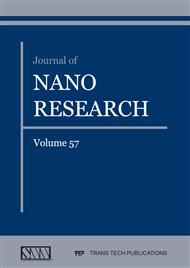[1]
Rattan. A., Sachdeva, P. and Chaudhary, A. Use of nanomaterials in concrete, International Journal of Latest Research in Engineering and Technology, 2(5) (2016) 81-84.
Google Scholar
[2]
Gopinath. S., Mouli. P., Murthy. A.R., Iyer. N.R. and Maheswaran. S. Effect of nano silica on mechanical properties and durability of normal strength concrete, Archives of Civil Engineering, 8(4) (2012) 433-444.
DOI: 10.2478/v.10169-012-0023-y
Google Scholar
[3]
Vikash Kumar, Ashhad Imam, Vikas Srivastava, Atul and Kushwaha. Y. Effect of micro silica on the properties of hardened concrete, International Journal of Engineering Research and Development, 13(11) (2017) 08-12.
Google Scholar
[4]
Siddique. R. and Mehta. A. Effect of carbon nanotubes on properties of cement mortars, Construction and Building Materials, 50 (2014) 116-129.
DOI: 10.1016/j.conbuildmat.2013.09.019
Google Scholar
[5]
Swetha. M. and Lilly Rose. A. Alternative building materials using industrial and agricultural waste, Key Engineering Materials, 650 (2015) 01-12.
Google Scholar
[6]
Verma Ajay, Chandak Rajeec and Yadav. R.K. Effect of micro silica on the strength of concrete with ordinary Portland cement, Research Journal of Engineering Science, 1(3) (2012) 1-4.
Google Scholar
[7]
Tanveer Hussain. S. and Gopala Krishna Sastry. K.V.S. Study of strength properties of concrete by using micro silica and nano silica, International Journal of Research in Engineering and Technology, 3(10) (2014) 103-108.
DOI: 10.15623/ijret.2014.0310016
Google Scholar
[8]
Nazari A and Riahi S. The effects of SiO2 nanoparticles on physical and mechanical properties of high strength compacting concrete, Composites Part B, 42 (2011) 570-578.
DOI: 10.1016/j.compositesb.2010.09.025
Google Scholar
[9]
Hasan Biricik and Nihal Sarier. Comparative study of the characteristics of nanosilica, silica fume and fly ash incorporated cement mortars, Materials Research, 17(3) (2014) 570-582.
DOI: 10.1590/s1516-14392014005000054
Google Scholar
[10]
Zhang. M.H. and Islam. J. Use of nanosilica to reduce setting time and increase early strength of concretes with high volumes of fly ash or slag, Construction and Building Materials, 29 (2012) 573-580.
DOI: 10.1016/j.conbuildmat.2011.11.013
Google Scholar
[11]
Hou. P., Kawashima. S., Wang. K., Corr. D.J., Qian. J. and Shah. S.P. Effects of colloidal nanosilica on rheological and mechanical properties of fly ash-cement mortar, Cement and Concrete Composites, 35(1) (2013) 12-22.
DOI: 10.1016/j.cemconcomp.2012.08.027
Google Scholar
[12]
Burgos Montes. O., Palacios. M., Rivilla. P. and Puertas. F. Compatibility between super plasticizer admixtures and cements with mineral additions, Construction and Building Materials, 31 (2012) 300-309.
DOI: 10.1016/j.conbuildmat.2011.12.092
Google Scholar
[13]
Raut. S.P., Mandavgane. S.A. and Ralegaonkar. R.V. Application of small scale experimental models for thermal comfort assessment of sustainable building materials, International Journal of Civil Engineering, 12(4) (2014) 01-08.
Google Scholar
[14]
Nallusamy, S. and Gautam Majumdar. Effect of stacking sequence and hybridization on mechanical properties of jute-glass fiber composites, International Journal of Performability Engineering, 12(3) (2016) 229-239.
Google Scholar
[15]
Dakwale and Ralegaonkar. Development of sustainable construction material using construction and demolition waste, Indian Journal of Engineering and Material Science, 21 (2014) 451-457.
Google Scholar
[16]
Rao. G.A. Investigations on the performance of silica fume incorporated cement pastes and mortars, Cement and Concrete Research, 33 (2003) 1765-1770.
DOI: 10.1016/s0008-8846(03)00171-6
Google Scholar
[17]
El-Fgaier, Brachelet and Chapiseau. Thermal performance of unfired clay bricks used in construction in the north of France: Case study, Case Studies in Construction Materials, 3 (2015) 102-111.
DOI: 10.1016/j.cscm.2015.09.001
Google Scholar
[18]
Davoud Tavakoli and Ali Heidari. Properties of concrete incorporating silica fume and nano SiO2, Indian Journal of Science and Technology, 6(1) (2013) 45-52.
DOI: 10.17485/ijst/2013/v6i1.12
Google Scholar
[19]
Prasada Rao. D.V. and Pavan Kumar. M. A study on influence of fly ash and nanosilica on strength properties of concrete, International Journal of Advanced Research in Engineering and Technology, 5 (2014) 94-102.
Google Scholar
[20]
Bredenoord. J. Sustainable building materials for low cost housing and the challenges facing their technological developments, Journal of Architectural Engineering Technology, 6(1) (2017) 03-11.
DOI: 10.4172/2168-9717.1000187
Google Scholar
[21]
Saloma Amrinsyah Nasution, Iswandi Imran and Mikrajuddin Abdullah. Improvement of concrete durability by nano materials, Procedia Engineering, 125 (2015) 608-612.
DOI: 10.1016/j.proeng.2015.11.078
Google Scholar
[22]
Sabir Shafi Lone, Megha Gupta and Geeta Mehta. Comparative study of nano-silica induced mortar, concrete and self-compacting concrete-A review, Indian Journal of Science and Technology, 9(44) (2016) 1-7.
DOI: 10.17485/ijst/2016/v9i44/105288
Google Scholar
[23]
Madhusudanan. S. and Amirtham. Optimization of construction cost using industrial wastes in alternative building material for walls, Key Engineering Materials, 692 (2016) 1-8.
DOI: 10.4028/www.scientific.net/kem.692.1
Google Scholar
[24]
Kulkarni. M.S., Mirgal. P.G., Bodhale. P.P. and Tande. S.N. Effect of rice husk ash on properties of concrete, Journal of Civil Engineering and Environmental Technology, 1(1) (2014) 26-29.
Google Scholar
[25]
Zhang. M., Wang. H. and Dan Zhang. J. Mechanical property of pavement concrete with nano-particles, Advanced Materials Research, 168-170 (2011) 1896-1899.
DOI: 10.4028/www.scientific.net/amr.168-170.1896
Google Scholar


